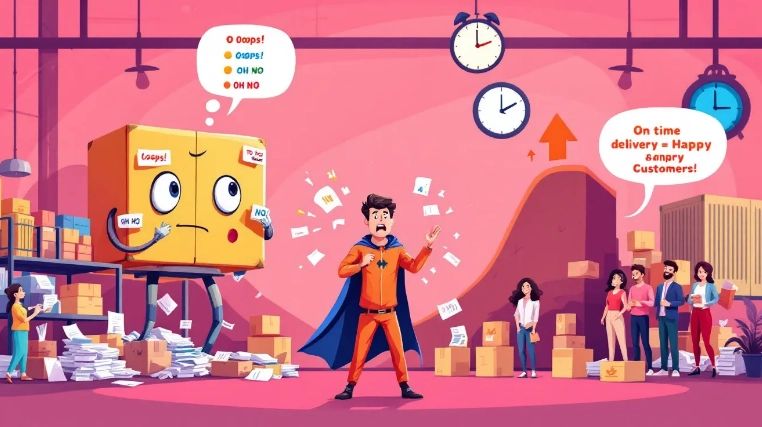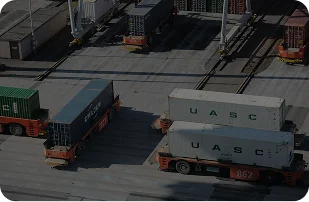Top 7 Order Fulfillment Mistakes and How to Avoid Them

Order fulfillment mistakes can hurt your business. In this article, we cover the top 7 errors businesses make and how to avoid them. By spotting these issues early, you can improve your process and keep customers happy.
The Significance of Efficient Order Fulfillment
Efficient order fulfillment directly impacts business success by ensuring prompt and flawless delivery. Effective order management system helps maintain a stellar reputation and achieve profitability. Streamlined processes enable businesses to meet customer expectations for fast and transparent delivery, significantly influencing overall satisfaction.
For businesses shipping lightweight items directly to consumers, implementing effective small parcel shipping solutions can dramatically reduce delivery times and costs while minimizing handling errors that lead to customer dissatisfaction.
Conversely, poor order fulfillment often leads to damaged items and lost customers, severely affecting business growth. The consequences of inefficient order fulfillment processes are far-reaching, including customer dissatisfaction, increased returns, and negative reviews. Customers today have high expectations for quick and incident-free delivery, and failing to meet these expectations can erode loyalty.
Efficiently locating, packaging, and shipping items in a timely manner remains a significant challenge. Coordinated efforts across various fulfillment aspects are necessary. Prioritizing accuracy and speed ensures customers receive their orders as expected, fostering trust and repeat business.
Order fulfillment isn’t solely about speed; accuracy and reliability throughout the entire fulfillment process are equally important. Each step, from inventory management to shipping, must be optimized to prevent errors and delays. Focusing on these aspects enhances supply chain efficiency and ensures customer satisfaction.
Common Order Fulfillment Mistakes Businesses Make
Minimizing common order fulfillment mistakes is vital for online business growth. These errors often arise from inefficient processes, leading to more mistakes and decreased customer satisfaction. As businesses expand, the complexity of order fulfillment increases, making mistakes more likely.
We’ve identified seven common ecommerce fulfillment mistakes that businesses frequently make. Understanding these pitfalls and implementing strategies to avoid them helps streamline fulfillment operations and enhance overall efficiency.
Let’s explore these mistakes in detail.
Poor Inventory Management
Inaccurate inventory management causes stockouts or overstocks, leading to delays and increased fulfillment costs. Effective inventory control is crucial for timely and accurate order fulfillment. Stock distortion can cost businesses $1.1 trillion globally, highlighting the severe financial impact of poor inventory practices.
A robust inventory management system accurately tracks inventory levels and prevents discrepancies. Automated inventory management software provides real-time visibility, crucial for avoiding stockouts and overstocks. Real-time tracking significantly improves inventory accuracy and helps mitigate fulfillment errors.
Inaccuracies in inventory management often stem from manual data entry errors, causing discrepancies in stock levels. Ineffective demand forecasting can result in both overstocking and understocking, leading to inefficiencies. Integrating advanced technology and conducting regular audits are essential for maintaining accurate inventory levels and ensuring efficient order fulfillment.
Packing Errors
Packing errors can lead to damaged products and unhappy customers. Incorrect packing results in costly returns, disappointed customers, and poor reviews.
Ill-fitting packing materials, untrained staff, and careless handling contribute to packing errors. Low-quality packaging can damage products during transit, negatively impacting customer satisfaction. Using high-quality materials and providing proper staff training can mitigate these issues and enhance the packing process.
Shipping Delays
Inefficient order processing significantly contributes to slow shipping, leading to customer dissatisfaction. Slow shipping can result in negative reviews and decreased sales, with 84% of purchasers unlikely to shop with a brand again after a negative delivery experience. Consumers expect quick delivery and may shop elsewhere if delivery is delayed.
Shipping delays often result from inefficient order processing, inventory inaccuracies, and poor warehouse management. Other factors include customer location, carrier choice, and customs requirements. Partnering with reputable carriers and ensuring proper packaging quality can minimize shipping delays.
The right technology and shipping carrier systems, especially during high-volume seasons, enhance shipping efficiency. Optimizing workflows and automating packing can help reduce delays. Integrating with shipping carriers automates label generation, booking shipments, and tracking packages, improving the shipping process and the fulfillment process.
Ineffective Communication with Customers
Poor communication impacts logistics operations, brand image, customer loyalty, cash flow, and overall business goals. Ineffective communication increases customer inquiries and dissatisfaction. If not addressed proactively, customers may feel ignored and frustrated.
Implementing tools like a Knowledge Base and live chat features significantly improves customer communication. Providing clear and timely updates on order status enhances customer satisfaction and reduces inquiries. Effective communication ensures customers feel valued and informed throughout the delivery process.
High Shipping Costs
Determining shipping charges that are both competitive and profitable is often challenging. Ineffective box sizing increases shipping costs and the chances of damage. Over-packing can result in higher material costs, shipping expenses, and environmental waste.
Overlooking shipping costs can erode profits. To mitigate this, businesses should negotiate better shipping rates by leveraging volume discounts and building relationships with shipping partners. Optimizing packaging and shipping strategies reduces costs and improves overall profitability.
Inadequate Returns Management
Inadequate returns management significantly affects customer loyalty, with 85% of online shoppers likely to shop elsewhere after a poor delivery experience. Common challenges include long processing times, unclear return policies, and inefficiencies in restocking, leading to disillusioned clients and increased operational costs.
Confusing return policies and limited options create customer frustration, reducing overall satisfaction with the buying experience. Effective returns management is crucial for sustaining profitability, as highlighted by the high return rates in ecommerce sales.
Implementing clear return policies and efficient restocking processes can enhance customer satisfaction and loyalty.
Scalability Issues
Neglecting scalability in order fulfillment can result in increased inefficiencies and operational errors as a business expands. As businesses grow, inefficiencies and errors can become more pronounced. Investing in scalable systems is critical to maintaining efficiency and accuracy in order fulfillment.
This becomes particularly critical during high-volume seasons, where thanksgiving challenges can overwhelm unprepared fulfillment operations and lead to shipping delays, inventory discrepancies, and damaged customer relationships that persist long after the holiday season ends.
Implementing scalable systems significantly enhances order fulfillment processes and supports business growth. Planning for scalability ensures fulfillment operations remain efficient and effective, even as order volumes increase.
Leveraging Technology for Efficient Order Fulfillment
Leveraging technology in order fulfillment significantly minimizes human errors and improves order accuracy. Automating fulfillment tasks enhances operational efficiency and helps businesses scale effectively. For example, Trans-Matic reduced its receiving time from 3 hours daily to just 20 minutes through enhanced processes.
Many businesses discover that the 3PL advantage extends beyond cost savings to include access to advanced fulfillment technologies and expertise that would be prohibitively expensive to develop in-house, allowing even small companies to offer enterprise-level fulfillment experiences.
Utilizing barcode scanning and RFID technology in warehouses streamlines the order fulfillment process and reduces errors. Real-time visibility into operations, as demonstrated by a leading pharmaceutical manufacturer, improves overall fulfillment efficiency.
Adopting these technological advancements allows businesses to optimize their fulfillment operations and achieve accurate order fulfillment.
Aligning Your Fulfillment Strategy with Business Goals
Integrating order fulfillment processes with business objectives enhances supply chain efficiency and meets customer expectations. Collaboration between departments, such as marketing and logistics, is vital for aligning fulfillment strategies with overarching business goals.
Cloud-based warehouse management systems significantly enhance operational efficiency and flexibility. Implementing advanced analytics improves decision-making through insights derived from operational data. A responsive order fulfillment strategy contributes to better customer satisfaction and loyalty by meeting delivery expectations.
Order Fulfillment Mistakes FAQs
What are the 7 steps of order fulfillment?
The 7 steps of order fulfillment are:
- Receiving inventory
- Storing products
- Processing orders
- Picking items
- Packing orders
- Shipping packages
- Handling returns
These steps ensure efficient order processing, timely delivery, and customer satisfaction.
How do you ensure order accuracy?
Ensure order accuracy by using barcode scanning, automated inventory management, and quality control checks. Implement double-check procedures during picking and packing, train staff on accuracy best practices, and integrate real-time tracking to minimize errors.
What is the initial step in the order fulfillment process?
The initial step in the order fulfillment process is receiving inventory. This involves inspecting, counting, and storing products in the warehouse to ensure accurate stock levels and efficient order processing.
What are the three types of order fulfillment?
The three types of order fulfillment are in-house fulfillment, third-party logistics (3PL), and dropshipping. In-house fulfillment means managing orders internally, 3PL involves outsourcing logistics to a provider, and dropshipping allows suppliers to ship directly to customers.
What is a good order fulfillment rate?
A good order fulfillment rate is 95% or higher. This means at least 95% of orders are processed, shipped, and delivered on time without errors. High fulfillment rates improve customer satisfaction and operational efficiency.
How Innovative Warehouse Solutions, LLC Can Help
Innovative Warehouse Solutions, LLC specializes in warehouse layout storage and logistics solutions, securely storing products and distributing them directly to clients. IWS allows users to upload multiple orders at once via a CSV file for simplicity and ease, alongside providing customizable reports for analyzing business performance.
Through strategic warehousing approaches, IWS optimizes inventory placement, picking paths, and storage utilization to minimize handling time and errors, creating more efficient fulfillment operations that scale with your business growth while maintaining accuracy and speed.
Innovative Warehouse Solutions, LLC prioritizes real-time, personalized customer support as part of its customer-centric service. Leveraging cutting-edge technology and industry insights, IWS provides tailored solutions for clients. Partnering with IWS ensures efficient order fulfillment and enhances overall supply chain efficiency.





